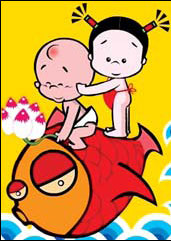

When it comes to clicks, the cyber world's measure of popularity, Xiaopohai and Xiaoya are the celebrities to beat. With an average of 160,000 viewers entering their website every day, these two cartoon characters have hogged the top spot on the Internet pop chart since their debut in 2002.
Born to a little known Shanghai studio, Xiaopohai, which literally means little poor boy, and his companion, Xiaoya, or little girl, have sallied off on their bumbling adventures to win the hearts of millions of loyal fans. In the process, they have transformed their birthplace into a small business with big ambitions.

Riding on the success of Xiaopohai, Shanghai Shihuang Animation is branching into the merchandising and other related businesses. With annual sales of no more than one million yuan, "we're still a small company", says Tian Pingyi, the company's general manager. But "the market potential for us is unlimited", he says, citing examples of Hello Kitty, the cat of Japanese origin, and Hong Kong-born piggy, McDull.
Created by Tian Yixin, better known by his pseudonym Shihuang, or garbage gatherer, Xiaopohai embodies the traditional impression of what cute children should be before they were seen by traditionalists to be spoiled and polluted by Western-style consumerism. "Its popularity was beyond our wildest expectations," the artist says.
Xiaopohai was created by accident. It was merely a casually drawn illustration Tian attached to a Mid-Autumn Festival greeting card he sent to a friend. On a whim, his friend posted the greeting card on his website and unexpectedly launched one of the most enduring celebrities in Chinese toonland.
The Internet is a relatively low-cost promotional channel for cartoons and is ideal for domestic animation start-ups. "Creativity and originality are vital to our company," Tian Pingyi says. "Our characters are distinct for its rich Chinese flavors." Many of the series' plots were inspired from traditional Chinese folk tales, he says.
"Jingyang Gang", an episode adapted from the well-known Chinese classical novel The Water Margin (Shui Hu Zhuan), which depicts a heroic warrior, Wu Song, slaughtering a tiger bare-handed, was adapted with the small and stalky Xiaopohai as the gallant Wu Song.
"We don't lack cartoon directors, but are short of cartoon directors with creativity," Tian says. "The loss of national identity in developing characters is inhibitive to the development of the creative industry."
Creativity also applies to Shihuang's business model. The majority of sales revenue in 2007 was generated from products derived from Xiaopohai. They include videos, comic books, clothing, kid snacks, fashion accessories, stationeries and toys.
"In 2008, we are planning to develop Internet games also based on the Xiaopohai theme," Tian says.
Shanghai was the third largest domestic cartoon production city, with 20 copies, or 10,855 minutes, behind Changsha and Guangzhou, according to a study by The China's State Administration of Radio Film and Television (SARFT).
In 2008, Shihuang Animation also intends to set up product display stands to promote the Xiaopohai brand in Shanghai, paving the way for the opening of a retail chain, Tian says.
But the company's ambition won't be achieved if cash flow remains tight, Tian laments. Because the industry chain is complex, touching on marketing, publishing and TV program production, the investment can be huge.
Shihuang is one of the few animation companies in Shanghai that are thinking big. "We currently have no plan to produce our own brand," says Xu Zhou, general manager of Benson Animation, an animation design company based in Shanghai. "The cost for developing a product of our own is simply too high," he explains.
There are those who have been actively seeking overseas venture capital to help finance the development costs. For instance, Hunan Greatdreams Cartoon Media, based in Changsha, Hunan Province, was the first Chinese studio to receive a capital injection of $7.5 million from Sequoia Capital China.
But venture capital companies are very cautious about investing in the animation industry, Tian says. The fist venture capital firm to show interest in Shihuang was back to 2004, but "we haven't received any cash from it yet", he says.
But the latest government move to protect and encourage the development of the creative industry is seen to offer domestic animation companies some hope. This February, a circular released by SARFT announced a ban on airing foreign cartoons on domestic channels from 5pm to 9pm, extending last year's ban by one hour.
But talent scarcity in product development and marketing strategies are still acute, Tian says. "We outsourced part of our marketing business to some specialized companies. We are not marketing savvy, and this has distracted our attention." Marketing companies with expertise in the cartoon field are in short supply, he adds.
Shihuang is also bothered by rampant piracy problems. "There are more than ten pirated products that have been circulated in the market, as far as I know," Tian says. In 2007, Shihuang accused two Shanghai-based stationery manufacturers of illegally using of Xiaopohai images on their products. Shihuang won eighty thousand Yuan in compensation, Tian says.
Broadcasting fees paid by TV stations were quite low, from five yuan to a hundred yuan per minute, some even refused to pay the copyright fees, Tian says. "Official supervision on broadcasters may help to solve this problem," he says.
It is still a promising industry, even many problems still need to be solved, Tian says. According to a report issued by China Investment Consulting Net, the domestic cartoon consumption market is at least worth 500 million yuan, and the derivative products are estimated to have 280 billion yuan value.
(China Daily 04/07/2008 page6)













